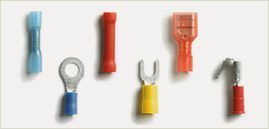It is exciting to think about a new boating season, and getting your boat ready for the season helps to build that excitement. Knowing that the electrical connections on your boat are safe and secure gives you peace of mind and minimizes problems that can occur when you are on the water. Spring is a good time to check all the wiring and electrical connections in your boat. The wires inside a boat are exposed to hostile conditions such as salt, water, harsh sunlight, wind, variant temperatures, and oil. Problems occur with corrosion, stress, vibrations, and movement in a boat and you’ll find that many of your connections have probably weakened or become loose. It is important to have safe and reliable electrical connections and checking the condition of your boats electrical system before you hit the water is time well spent.
Why You Should Care About Cable Management
Marine wiring is unique in that the wiring used in boats need to be both flexible and corrosion resistant. Electrical connections at the wire ends and splices in the middle of wires are the most frequent failure points for any wire connections. Before replacing electrical wires and connections in boats, it is important to follow the ABYC standards for how connections must be made. Wiring in marine applications must be made using stranded copper, not solid wire. Stranded wires provide the flexibility and strength needed for the standards set forth by the American Boat and Yacht Council for the repair of electrical equipment and wiring.

Butt Connectors, Butt Splices connect wires in Marine Applications
The preferred way of splicing two electrical wires together is to use butt connectors. A butt connector is a nylon or vinyl sheathed tube where wires are inserted in the two ends of the tube and each end is crimped using a crimping tool. Butt splices can be used when there are two wire of different sizes; but the best result is when the same size wire is used throughout an installation.
For applications in bilge and engine spaces, or where wires are exposed to water, the most reliable way to secure a connection is to use heat shrink insulated butt splice connectors with a hot-melt adhesive inside. It is easy to do, just insert the wire, crimp the connection and then use a heat gun to melt the adhesive inside. When cooled, the heat shrink terminal creates a secure and waterproof wire connection that can withstand force and tension from movement in a boat.
Ring & Spade Terminals connect Equipment Wiring Needs
Ring terminals and spade terminals are useful when making electrical connections on equipment and other ports that use a terminal screw. You’ll need to select the proper terminal by matching it to the wire gauge and the size of the terminal screw. Ring terminals are the best option unless the terminal screw is in inaccessible area, where in this case, you’ll need to use spade terminals as the open end makes it easier to access connection points.
Cable Ties & Zip Ties provide a Wire Management Solution
If you are installing DC or AC wiring in a boat, you’ll need to leave some wire slack so that it can move freely to compensate for temperature change and flexing of the boat movements. You should do a good job of securing wires as they go around corners and through bulkheads so that you minimize movement. Loose wire management reduces the tension from movement that can break wire connections apart, and it prevents damage to the insulation sleeve of the terminal connectors.
Nylon cable ties (also known as zip ties) are the most common method for creating a cable management layout. To secure wiring in bulkheads, you should use a reliable method such as mounting screw-on head cable ties. This allows you to safely mount the wires, pull the cable tie snug, and properly secure them no more than 18 inches apart. Saddle Mount Screw-On Cable Ties are another option for securing wires and cables to areas where vibration and other activity that can cause damage to the wires and wire connections.

Wire Stripping & Crimping Tools create Secure & Waterproof Connections
A boat owner should have a wire stripper and a good-quality crimper intended for AWG wire in their toolbox. You should use a good wire stripper and crimping tool that is made for AWG wire sizes. To create a secure and long lasting connection to terminals, a crimp connector is the preferred method of splicing wires that connect to circuit breakers or equipment.

Most crimped connections work well for years before one goes bad. But if you plan on going into situations where you have to rely on your boat, you should be prepared with the proper tools to get the job done right. Having a supply of terminal connectors, extra wiring and a AWG wire & crimp tool on board will go a long way in fixing electrical wiring issues you encounter, either on water or land.
Boat Cable reduces corrosion in Wires
Boat cable is marine grade copper wiring that is tinned to reduce or slow corrosion. The biggest problem is that copper wire corrodes. That’s why it is important to use multi-stranded, tinned copper wire with heavy duty insulation for marine applications. A multi-strand wire means that the wires are designed to withstand more flexing and vibration, and 'tinned' means that each of the multiple strands is individually coated to protect the copper wires. Most marine wiring is tinned to reduce or slow corrosion, as boat wire can corrode quickly and permanently if it is not properly installed.
Take time to check your boat’s electrical system and look for these conditions. Knowing that your electrical connections are secure and waterproof will make you better prepared for fun on the water. For more information about which electrical connectors to use in Boating, consult Electrical Basics at 877-947-8437.